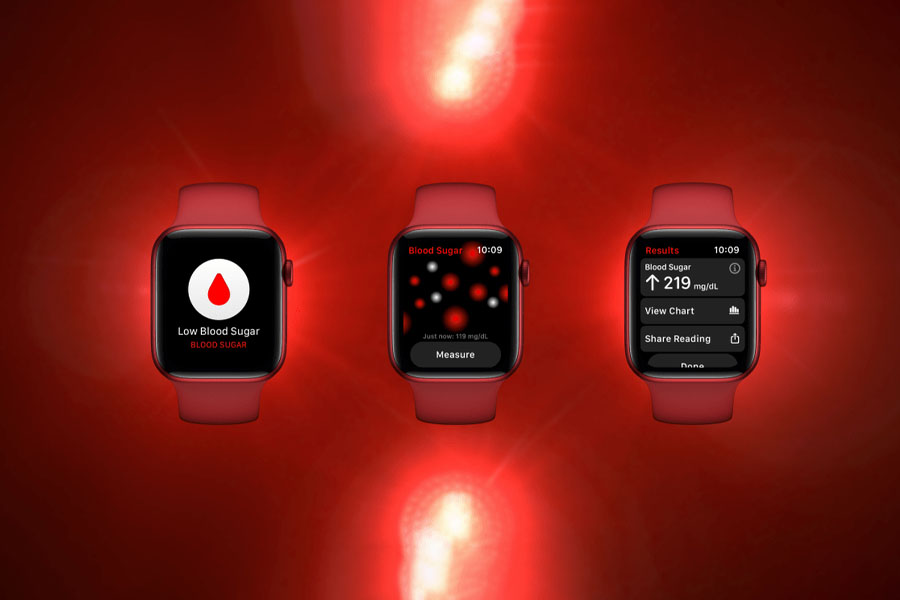
Apple Watch’s non-invasive (i.e. without having to draw blood) blood glucose measurement feature has been in development for over a decade now. We’ve been hearing that Apple is “ready” to bring it to market every once in a while. But a new report from reliable Apple leakster Mark Gurman says an Apple Watch with blood glucose monitoring is still several years away from production.
Blood glucose reading in Apple Watch Series
The traditional method of taking blood glucose readings requires one to inject a sample of their blood and send it to a lab. Or using a home kit that still needs a blood sample. Both of which are invasive processes. So you can already imagine that implementing non-invasive blood glucose measurement on a compact device like an Apple Watch is a tricky ordeal.

According to Gurman, Apple is likely to use a silicon photonics chip to shine light from a laser through the skin to determine the body’s glucose concentration. But the main challenge for the company is fitting this sensor inside the small and slim body of an Apple Watch. And Gurman suggests figuring this out could take another 3-7 years for Apple.
- Also Read:
- AirPods Pro 2 with USB-C charging is launching later this year
- Apple’s M3 chip will power the new 13 and 15-inch MacBook Air
- iPhone SE 4 isn’t dead after all: Will feature Apple’s own 5G modem
- Apple may finally ditch the bathtub-like notch from iPhone 15
Why it’s so important
If this technology eventually comes to market, it will be able to warn Apple Watch users if they are prediabetic and encourage them to make healthier lifestyle changes to lower the chances of developing diabetes. In case you didn’t know, there is currently no cure for diabetes. And it can only be managed through strict dietary plans or regular medications. So, prevention is obviously the best option here.

Apple has been working on this technology since 2010. And the project was initiated by Steve Jobs himself after he bought “RareLight”. It was a company that envisioned non-invasive blood glucose monitoring. The technology was then being worked on in a secret facility by Avolonte Health LLC before being transferred to the Exploratory Design Group (XDG).
- Meanwhile, check out our review of the Apple Watch Ultra.







![Best Gaming Laptops in Nepal Under Rs. 250,000 (रु 2.5 Lakhs) [2025] Best Gaming Laptops Under 2.5 lakhs in Nepal [Feb 2025 Update]](https://cdn.gadgetbytenepal.com/wp-content/uploads/2025/02/Best-Gaming-Laptops-Under-2.5-lakhs-in-Nepal-Feb-2025-Update.jpg)
![Best Gaming Laptops in Nepal Under Rs. 120,000 (रु 1.2 Lakhs) [2025] Best Budget Gaming Laptops Under Rs 120000 in Nepal 2025 Update](https://cdn.gadgetbytenepal.com/wp-content/uploads/2025/05/Best-Budget-Gaming-Laptops-Under-Rs-120000-in-Nepal-2024-Update.jpg)
![Best Laptops Under Rs. 80,000 in Nepal [2025] Best Laptops Under 80,000 in Nepal March 2025 Update](https://cdn.gadgetbytenepal.com/wp-content/uploads/2025/03/Best-Laptops-Under-80000-in-Nepal-March-2025-Update.jpg)
![Best Gaming Laptops in Nepal Under Rs. 200,000 (रु 2 Lakhs) [2025] Best gaming lapotp under 2 lakhs Nepal Feb 2025](https://cdn.gadgetbytenepal.com/wp-content/uploads/2025/01/Best-Gaming-Laptops-Under-2-Lakh-Nepal-Feb-2025-Update.jpg)

![Best Mobile Phones Under Rs. 15,000 in Nepal [Updated 2025] Best Phones Under 15000 in Nepal 2024 Budget Smartphones Cheap Affordable](https://cdn.gadgetbytenepal.com/wp-content/uploads/2024/03/Best-Phones-Under-15000-in-Nepal-2024.jpg)
![Best Mobile Phones Under Rs. 20,000 in Nepal [Updated] Best Mobile Phones Under NPR 20000 in Nepal 2023 Updated Samsung Xiaomi Redmi POCO Realme Narzo Benco](https://cdn.gadgetbytenepal.com/wp-content/uploads/2024/01/Best-Phones-Under-20000-in-Nepal-2024.jpg)
![Best Mobile Phones Under Rs. 30,000 in Nepal [Updated 2025] Best Phones Under 30000 in Nepal](https://cdn.gadgetbytenepal.com/wp-content/uploads/2025/01/Best-Phones-Under-30000-in-Nepal.jpg)
![Best Mobile Phones Under Rs. 40,000 in Nepal [Updated 2025] Best Phones Under 40000 in Nepal 2024 Smartphones Mobile Midrange](https://cdn.gadgetbytenepal.com/wp-content/uploads/2024/02/Best-Phones-Under-40000-in-Nepal-2024.jpg)
![Best Mobile Phones Under Rs. 50,000 in Nepal [Updated 2025] Best Phones Under 50000 in Nepal](https://cdn.gadgetbytenepal.com/wp-content/uploads/2025/01/Best-Phones-Under-50000-in-Nepal.jpg)
![Best Flagship Smartphones To Buy In Nepal [Updated] Best flagship phone 2025](https://cdn.gadgetbytenepal.com/wp-content/uploads/2024/07/Best-Flagship-Phones-who-is-it-ft-1.jpg)